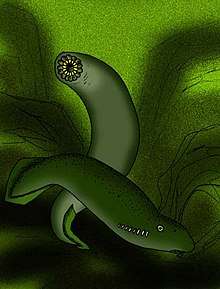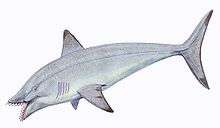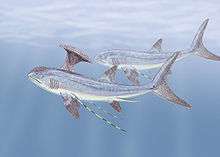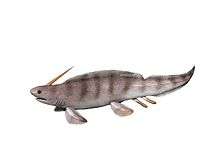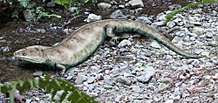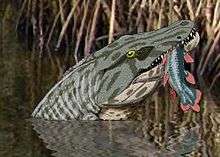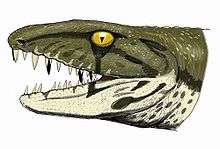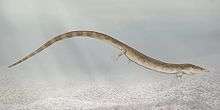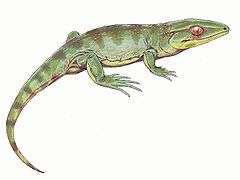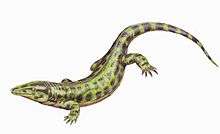Moscovian (Carboniferous)
The Moscovian is in the ICS geologic timescale a stage or age in the Pennsylvanian, the youngest subsystem of the Carboniferous. The Moscovian age lasted from 315.2 to 307 Ma,[2] is preceded by the Bashkirian and is followed by the Kasimovian. The Moscovian overlaps with the European regional Westphalian stage and the North American Atokan and Desmoinesian stages.
| System | Subsystem/ Series |
Stage | Age (Ma) | |
|---|---|---|---|---|
| Permian | Cisuralian | Asselian | younger | |
| Carboniferous | Pennsylvanian | Gzhelian | 298.9 | 303.7 |
| Kasimovian | 303.7 | 307.0 | ||
| Moscovian | 307.0 | 315.2 | ||
| Bashkirian | 315.2 | 323.2 | ||
| Mississippian | Serpukhovian | 323.2 | 330.9 | |
| Visean | 330.9 | 346.7 | ||
| Tournaisian | 346.7 | 358.9 | ||
| Devonian | Late | Famennian | older | |
| Subdivision of the Carboniferous system according to the ICS, as of 2017.[1] | ||||
Name and definition
The Moscovian stage was introduced by Sergei Nikitin (1850 - 1909) in 1890, using brachiopods in the Moscow Basin of European Russia. Nikitin named the stage after Moscow, then a major city and now the capital of Russia.
The base of the Moscovian is close to the first appearances of the conodonts Declinognathodus donetzianus and Idiognathoides postsulcatus[3] or otherwise the fusulinid Aljutovella aljutovica.[4] Because the fusulinid species are regionally different, they can not be used for worldwide correlation. A golden spike for the Moscovian stage has yet to be defined (2008). A proposal is to use the first appearance of the conodont Diplognathodus ellesmerensis, but since the species is rare and its evolution relatively unknown, it has not been accepted yet.[5]
The top of the Moscovian (base of the Kasimovian) is at the base of the fusulinid biozone of Obsoletes obsoletes and Protriticites pseudomontiparus, or with the first appearance of the ammonite genus Parashumardites.
Subdivisions
In European Russia and Eastern Europe, where the stage was first recognized, the Moscovian is subdivided into four regional substages: Vereiskian, Kashirskian, Podolskian, and Myachkovskian, named after towns near Moscow (Vereya, Kashira, Podolsk, and Myachkovo).
The Moscovian can biostratigraphically be divided into five conodont biozones:
- Neognathodus roundyi and Streptognathodus cancellosus Zone
- Neognathodus medexultimus and Streptognathodus concinnus Zone
- Streptognathodus dissectus Zone
- Neognathodus uralicus Zone
- Declinognathodus donetzianus Zone
Moscovian life
Arthropods
| Arthropoda of the Moscovian | ||||
|---|---|---|---|---|
| Taxa | Presence | Location | Description | Images |
| Scotland and northeastern North America (Illinois) | A 2 m (79 in) long millipede |
| ||
| Illinois, United States | A millipede | |||
Jawless fishes
| Agnatha of the Moscovian | ||||
|---|---|---|---|---|
| Taxa | Presence | Location | Description | Images |
| Pennsylvanian | United States, Illinois | A basal vertebrate. |
| |
Cartilaginous fishes
| Chondrichthyes of the Moscovian | ||||
|---|---|---|---|---|
| Taxa | Presence | Location | Description | Images |
| Pennsylvanian | Illinois, Indiana, United States | A symmoriid holocephalian |
| |
| Carboniferous to Cisuralian | Iowa, Indiana, United States; Russia | A eugeneodontid holocephalian | ||
|
Carboniferous | Indiana, United States | A eugeneodontid holocephalian | |
| Carboniferous to Lopingian | Ohio, Illinois, United States | a petalodontiform holocephalian | ||
| Pennsylvanian | Indiana, United States | A eugeneodontid holocephalian | ||
| Devonian to Pennsylvanian | Indiana, United States | A orodontid holocephalian | ||
| Carboniferous to Cisuralian | England, Czech Republic | A xenacanthidan elasmobranch | ||
| Pennsylvanian | Indiana, United States | A symmoriid holocephalian | ||
| Pennsylvanian | Illinois, United States | A symmoriid holocephalian | ||
| Carboniferous to Cisuralian | Czech Republic, Germany, United Kingdom | A xenacanthidan elasmobranch | ||
Amphibians
Tetrapodomorphs
| Tetrapodomorphs of the Moscovian | ||||
|---|---|---|---|---|
| Taxa | Presence | Location | Description | Images |
| Desmoinesian | Allegheny Formation, Linton, Ohio | A genus of basal amphibians in the family Colosteidae. |
| |
|
Desmoinesian | Allegheny Formation, Linton, Ohio | A genus of basal amphibians in the family Baphetidae. | |
†Temnospondyls
| Temnospondyls of the Moscovian | ||||
|---|---|---|---|---|
| Taxa | Presence | Location | Description | Images |
| Allegheny Formation, Linton, Ohio | Adamanterpeton is a genus of edopoid temnospondyl within the family Cochleosauridae. |
| ||
| Great Britain; Ohio, USA | A genus of giant eel-like embolomere amphibian, that could reach up to 3 meters in length. | |||
| Czech Republic | A genus of basal temnospondyl. It reached a length of 150 cm. | |||
| Czech Republic;
Nova Scotia, Canada |
A genus of edopoid temnospondyl within the family Cochleosauridae. | |||
| Nova Scotia, Canada | A basal eutemnospondyl amphibian. | |||
| Allegheny Formation, Linton, Ohio | A genus of dvinosaurian amphibian within the family Eobrachyopidae. | |||
| Allegheny Formation, Linton, Ohio | A genus of dvinosaurian amphibian within the family Eobrachyopidae. | |||
| Allegheny Formation, Linton, Ohio | A genus of embolomere amphibian within the family Eogyrinidae. | |||
| Allegheny Formation, Linton, Ohio | A genus of edopoid temnospondyl within the family Cochleosauridae. | |||
| Allegheny Formation, Linton, Ohio | A genus of amphibamiform amphibian. | |||
| Allegheny Formation, Linton, Ohio | A genus of euskelian amphibian. | |||
†Lepospondyls
| Lepospondyls of the Moscovian | ||||
|---|---|---|---|---|
| Taxa | Presence | Location | Description | Images |
| Allegheny Formation, Linton, Ohio | Pleuroptyx is an extinct genus of lysorophian lepospondyls within the family Cocytinidae. | |||
|
Nyrany, Czech Republic | Sauropleura is an extinct genus of nectridean lepospondyls within the family Urocordylidae. | ||
Reptiliomorphs
| Reptiliomorphs of the Moscovian | ||||
|---|---|---|---|---|
| Taxa | Presence | Location | Description | Images |
| England, Scotland | An embolomere |
| ||
| Czech Republic | A genus of eogyrinid embolomere. Diplovertebron was around 50 cm in length. | |||
| England | An eogyrinid embolomere. | |||
| Ohio, USA | A genus of gephyrostegid reptiliomorph amphibian, similar in appearance to Gephyrostegus. | |||
| Nyran, Czech Republic | A genus of gephyrostegid reptiliomorph amphibian. A small animal, 22 cm in length, of generally lizard-like build and presumably habit. It had large eyes and a large number of small, pointed teeth, indicating it was an active insectivorous hunter. | |||
| Upper Freeport Coal Member, Ohio | A genus of eogyrinid embolomere. | |||
| Czech Republic | Traditionally classified as a close relative of amniotes a later study found that it was more closely related to the amphibian group Lepospondyli. It measured around 45cm long. | |||
Synapsids
| Synapsids of the Moscovian | ||||
|---|---|---|---|---|
| Taxa | Presence | Location | Description | Images |
| Pennsylvanian | Nova Scotia, Canada | An ophiacodontid |
| |
| Pennsylvanian | Illinois, United States | An ophiacodontid | ||
| Pennsylvanian | Nova Scotia, Canada | A varanopid | ||
| Nova Scotia, Canada | A basal synapsid. | |||
References
- http://www.stratigraphy.org/index.php/ics-chart-timescale
- Gradstein, F.M.; Ogg, J.G. & Smith, A.G.; 2004: A Geologic Time Scale 2004, Cambridge University Press
-
- Nemyrovska, T.I.; 1999: Bashkirian conodonts of the Donets Basin, Ukraine. Scr. Geol. 119, pp 1–115 (in Russian).
-
- Solovieva, M.N.; 1986: Zonal fusulinid scale of the Moscovian Stage based on a revision of the type sections of intrastage subdivisions, Vopr. Mikropaleontol
- Archived 2011-07-07 at the Wayback Machine a report by the taskforce to establish a Bashkirian-Moscovian boundary (Groves et al. (2008))
External links
- Carboniferous timescale at the website of the Norwegian network of offshore records of geology and stratigraphy
- Moscovian, Geowhen Database

